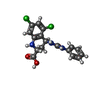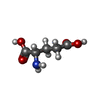[English] 日本語
 Yorodumi
Yorodumi- PDB-6usu: Crystal structure of GluN1/GluN2A ligand-binding domain in comple... -
+ Open data
Open data
- Basic information
Basic information
| Entry | Database: PDB / ID: 6usu | |||||||||
|---|---|---|---|---|---|---|---|---|---|---|
| Title | Crystal structure of GluN1/GluN2A ligand-binding domain in complex with L689,560 and glutamate | |||||||||
 Components Components |
| |||||||||
 Keywords Keywords | METAL TRANSPORT / NMDARs / LBD / Ion channels | |||||||||
| Function / homology |  Function and homology information Function and homology informationneurotransmitter receptor transport, plasma membrane to endosome / regulation of response to alcohol / response to ammonium ion / receptor recycling / directional locomotion / response to environmental enrichment / pons maturation / positive regulation of Schwann cell migration / regulation of cell communication / EPHB-mediated forward signaling ...neurotransmitter receptor transport, plasma membrane to endosome / regulation of response to alcohol / response to ammonium ion / receptor recycling / directional locomotion / response to environmental enrichment / pons maturation / positive regulation of Schwann cell migration / regulation of cell communication / EPHB-mediated forward signaling / Assembly and cell surface presentation of NMDA receptors / response to hydrogen sulfide / auditory behavior / olfactory learning / conditioned taste aversion / dendritic branch / serotonin metabolic process / regulation of respiratory gaseous exchange / response to other organism / protein localization to postsynaptic membrane / regulation of ARF protein signal transduction / cellular response to magnesium ion / transmitter-gated monoatomic ion channel activity / positive regulation of inhibitory postsynaptic potential / suckling behavior / response to methylmercury / response to manganese ion / response to glycine / propylene metabolic process / sleep / response to carbohydrate / regulation of NMDA receptor activity / locomotion / dendritic spine organization / cellular response to dsRNA / cellular response to lipid / regulation of monoatomic cation transmembrane transport / RAF/MAP kinase cascade / NMDA glutamate receptor activity / Synaptic adhesion-like molecules / voltage-gated monoatomic cation channel activity / response to glycoside / NMDA selective glutamate receptor complex / glutamate binding / ligand-gated sodium channel activity / neurotransmitter receptor complex / response to morphine / regulation of axonogenesis / glutamate receptor signaling pathway / neuromuscular process / calcium ion transmembrane import into cytosol / regulation of dendrite morphogenesis / protein heterotetramerization / male mating behavior / regulation of synapse assembly / glycine binding / spinal cord development / response to amine / parallel fiber to Purkinje cell synapse / cellular response to zinc ion / startle response / dopamine metabolic process / positive regulation of reactive oxygen species biosynthetic process / monoatomic cation transmembrane transport / response to lithium ion / response to light stimulus / positive regulation of calcium ion transport into cytosol / regulation of postsynaptic membrane potential / cellular response to glycine / associative learning / modulation of excitatory postsynaptic potential / action potential / conditioned place preference / excitatory synapse / positive regulation of dendritic spine maintenance / monoatomic cation transport / social behavior / regulation of neuronal synaptic plasticity / positive regulation of protein targeting to membrane / monoatomic ion channel complex / glutamate receptor binding / Unblocking of NMDA receptors, glutamate binding and activation / positive regulation of excitatory postsynaptic potential / long-term memory / synaptic cleft / neuron development / prepulse inhibition / phosphatase binding / multicellular organismal response to stress / positive regulation of synaptic transmission, glutamatergic / postsynaptic density, intracellular component / monoatomic cation channel activity / calcium ion homeostasis / response to fungicide / glutamate-gated receptor activity / cell adhesion molecule binding / regulation of neuron apoptotic process / cellular response to manganese ion / presynaptic active zone membrane / neurogenesis Similarity search - Function | |||||||||
| Biological species |  | |||||||||
| Method |  X-RAY DIFFRACTION / X-RAY DIFFRACTION /  SYNCHROTRON / SYNCHROTRON /  MOLECULAR REPLACEMENT / Resolution: 2.092 Å MOLECULAR REPLACEMENT / Resolution: 2.092 Å | |||||||||
 Authors Authors | Romero-Hernandez, A. / Tajima, N. / Chou, T. / Furukawa, H. | |||||||||
| Funding support |  United States, 2items United States, 2items
| |||||||||
 Citation Citation |  Journal: Cell / Year: 2020 Journal: Cell / Year: 2020Title: Structural Basis of Functional Transitions in Mammalian NMDA Receptors. Authors: Tsung-Han Chou / Nami Tajima / Annabel Romero-Hernandez / Hiro Furukawa /  Abstract: Excitatory neurotransmission meditated by glutamate receptors including N-methyl-D-aspartate receptors (NMDARs) is pivotal to brain development and function. NMDARs are heterotetramers composed of ...Excitatory neurotransmission meditated by glutamate receptors including N-methyl-D-aspartate receptors (NMDARs) is pivotal to brain development and function. NMDARs are heterotetramers composed of GluN1 and GluN2 subunits, which bind glycine and glutamate, respectively, to activate their ion channels. Despite importance in brain physiology, the precise mechanisms by which activation and inhibition occur via subunit-specific binding of agonists and antagonists remain largely unknown. Here, we show the detailed patterns of conformational changes and inter-subunit and -domain reorientation leading to agonist-gating and subunit-dependent competitive inhibition by providing multiple structures in distinct ligand states at 4 Å or better. The structures reveal that activation and competitive inhibition by both GluN1 and GluN2 antagonists occur by controlling the tension of the linker between the ligand-binding domain and the transmembrane ion channel of the GluN2 subunit. Our results provide detailed mechanistic insights into NMDAR pharmacology, activation, and inhibition, which are fundamental to the brain physiology. | |||||||||
| History |
|
- Structure visualization
Structure visualization
| Structure viewer | Molecule:  Molmil Molmil Jmol/JSmol Jmol/JSmol |
|---|
- Downloads & links
Downloads & links
- Download
Download
| PDBx/mmCIF format |  6usu.cif.gz 6usu.cif.gz | 131.9 KB | Display |  PDBx/mmCIF format PDBx/mmCIF format |
|---|---|---|---|---|
| PDB format |  pdb6usu.ent.gz pdb6usu.ent.gz | 98.5 KB | Display |  PDB format PDB format |
| PDBx/mmJSON format |  6usu.json.gz 6usu.json.gz | Tree view |  PDBx/mmJSON format PDBx/mmJSON format | |
| Others |  Other downloads Other downloads |
-Validation report
| Summary document |  6usu_validation.pdf.gz 6usu_validation.pdf.gz | 371.3 KB | Display |  wwPDB validaton report wwPDB validaton report |
|---|---|---|---|---|
| Full document |  6usu_full_validation.pdf.gz 6usu_full_validation.pdf.gz | 371.3 KB | Display | |
| Data in XML |  6usu_validation.xml.gz 6usu_validation.xml.gz | 1.8 KB | Display | |
| Data in CIF |  6usu_validation.cif.gz 6usu_validation.cif.gz | 8.9 KB | Display | |
| Arichive directory |  https://data.pdbj.org/pub/pdb/validation_reports/us/6usu https://data.pdbj.org/pub/pdb/validation_reports/us/6usu ftp://data.pdbj.org/pub/pdb/validation_reports/us/6usu ftp://data.pdbj.org/pub/pdb/validation_reports/us/6usu | HTTPS FTP |
-Related structure data
| Related structure data | 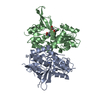 6usvC  6whrC 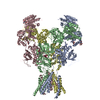 6whsC 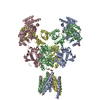 6whtC 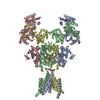 6whuC  6whvC 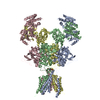 6whwC 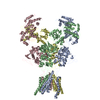 6whxC 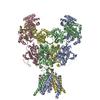 6whyC 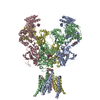 6wi0C 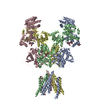 6wi1C  4nf8S S: Starting model for refinement C: citing same article ( |
|---|---|
| Similar structure data |
- Links
Links
- Assembly
Assembly
| Deposited unit | 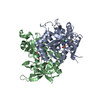
| ||||||||
|---|---|---|---|---|---|---|---|---|---|
| 1 |
| ||||||||
| Unit cell |
|
- Components
Components
| #1: Protein | Mass: 33340.031 Da / Num. of mol.: 1 / Fragment: UNP residues 415-565, 684-821 Source method: isolated from a genetically manipulated source Source: (gene. exp.)   |
|---|---|
| #2: Protein | Mass: 31785.299 Da / Num. of mol.: 1 / Fragment: UNP residues 402-539, 661-802 Source method: isolated from a genetically manipulated source Source: (gene. exp.)   |
| #3: Chemical | ChemComp-QGM / ( |
| #4: Chemical | ChemComp-GLU / |
| #5: Water | ChemComp-HOH / |
| Has ligand of interest | Y |
| Has protein modification | Y |
-Experimental details
-Experiment
| Experiment | Method:  X-RAY DIFFRACTION / Number of used crystals: 1 X-RAY DIFFRACTION / Number of used crystals: 1 |
|---|
- Sample preparation
Sample preparation
| Crystal | Density Matthews: 2.48 Å3/Da / Density % sol: 50.44 % |
|---|---|
| Crystal grow | Temperature: 291 K / Method: evaporation / pH: 7 Details: 0.2 M HEPES, pH 7.0, 60-90 mM sodium chloride, 15-20% PEG2000 MME |
-Data collection
| Diffraction | Mean temperature: 100 K / Serial crystal experiment: N |
|---|---|
| Diffraction source | Source:  SYNCHROTRON / Site: SYNCHROTRON / Site:  APS APS  / Beamline: 23-ID-B / Wavelength: 1.1 Å / Beamline: 23-ID-B / Wavelength: 1.1 Å |
| Detector | Type: DECTRIS EIGER X 16M / Detector: PIXEL / Date: Apr 6, 2013 |
| Radiation | Monochromator: Double crystal cryo-cooled Si(111) / Protocol: SINGLE WAVELENGTH / Monochromatic (M) / Laue (L): M / Scattering type: x-ray |
| Radiation wavelength | Wavelength: 1.1 Å / Relative weight: 1 |
| Reflection | Resolution: 2.09→40 Å / Num. obs: 38873 / % possible obs: 99.9 % / Redundancy: 7.6 % / Biso Wilson estimate: 25.56 Å2 / Rmerge(I) obs: 0.117 / Net I/σ(I): 17.1 |
| Reflection shell | Resolution: 2.09→2.18 Å / Redundancy: 6 % / Rmerge(I) obs: 0.62 / Num. unique obs: 3781 / CC1/2: 0.814 / % possible all: 99.8 |
- Processing
Processing
| Software |
| ||||||||||||||||||||||||||||||||||||||||||||||||||||||||||||||||||||||||||||||||||||
|---|---|---|---|---|---|---|---|---|---|---|---|---|---|---|---|---|---|---|---|---|---|---|---|---|---|---|---|---|---|---|---|---|---|---|---|---|---|---|---|---|---|---|---|---|---|---|---|---|---|---|---|---|---|---|---|---|---|---|---|---|---|---|---|---|---|---|---|---|---|---|---|---|---|---|---|---|---|---|---|---|---|---|---|---|---|
| Refinement | Method to determine structure:  MOLECULAR REPLACEMENT MOLECULAR REPLACEMENTStarting model: PDB entry 4NF8 Resolution: 2.092→38.161 Å / SU ML: 0.23 / Cross valid method: THROUGHOUT / σ(F): 1.36 / Phase error: 21.77
| ||||||||||||||||||||||||||||||||||||||||||||||||||||||||||||||||||||||||||||||||||||
| Solvent computation | Shrinkage radii: 0.9 Å / VDW probe radii: 1.11 Å | ||||||||||||||||||||||||||||||||||||||||||||||||||||||||||||||||||||||||||||||||||||
| Displacement parameters | Biso max: 77.3 Å2 / Biso mean: 27.2215 Å2 / Biso min: 12.93 Å2 | ||||||||||||||||||||||||||||||||||||||||||||||||||||||||||||||||||||||||||||||||||||
| Refinement step | Cycle: final / Resolution: 2.092→38.161 Å
| ||||||||||||||||||||||||||||||||||||||||||||||||||||||||||||||||||||||||||||||||||||
| LS refinement shell | Refine-ID: X-RAY DIFFRACTION / Rfactor Rfree error: 0
|
 Movie
Movie Controller
Controller













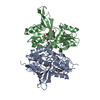
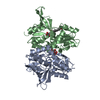

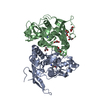
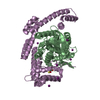



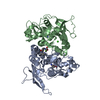
 PDBj
PDBj




